Sasco
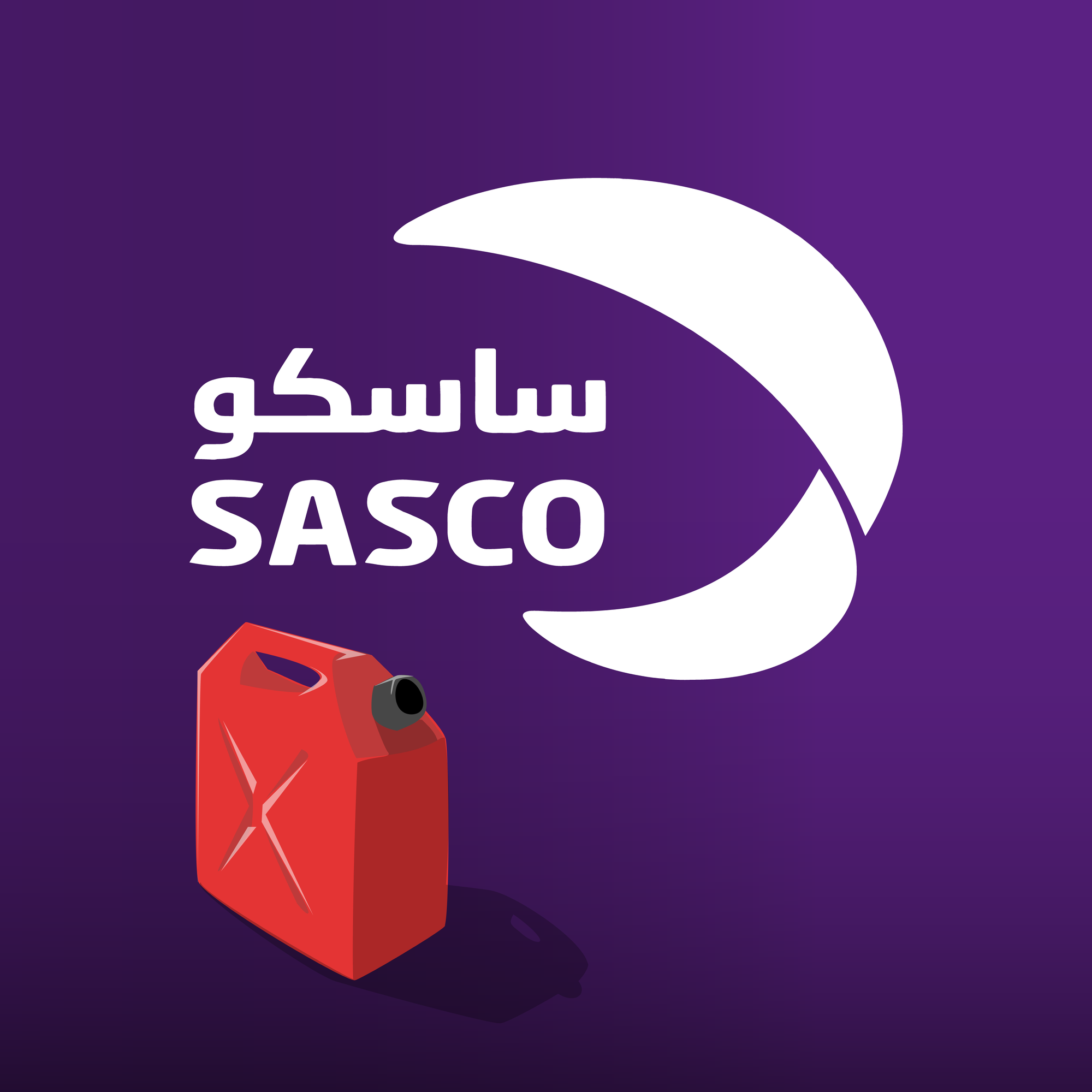
Saudi Automotive Services Company (SASCO) was established in Riyadh in 1982. It is the first company qualified to operate and manage fuel stations on highways. SASCO has innovated payment solutions at its stations that do not require cash or credit cards, and it was the first company to have its own app for its stations. These achievements are just a few of the reasons why SASCO is a leading company in providing its services and innovations.
The company's activities encompass a variety of services, including:
- Fuel stations
- Freight transportation
- Convenience stores
- Property leasing
- Hospitality services
- International licenses and customs transit books
- Car washes
- Contracting services
SASCO is committed to providing high-quality services according to international standards and is working on expanding its network of stations to offer an outstanding customer experience.
According to the CEO of SASCO, Riyadh bin Saleh Al-Malik, the company's current market share is 5.6% of the total number of stations. The company aims to increase this percentage by expanding its number of stations to 600 by the end of 2024 through acquisitions and the establishment of new locations.
SASCO strives to achieve Saudi Vision 2030 by offering innovative services and contributing to the development of the infrastructure of the fuel and transport sector in the Kingdom.
After getting a general understanding of the company, we move on to explore the company details. The following figure represents the timeline of the Saudi Automotive Services Company (SASCO).

The following figure represents the SWOT analysis for SASCO, illustrating the strengths, weaknesses, opportunities, and potential threats.

Overview of the Sector:
The fuel sector in Saudi Arabia is one of the key pillars of the national economy, given that the Kingdom is one of the largest producers and exporters of oil in the world. This sector is a vital part of economic development, contributing to the supply of energy needed for industries and transportation.
Structure and Regulation:
The sector encompasses several main areas such as oil production and refining, fuel distribution, and the operation of fuel stations, in addition to ancillary services like convenience stores, maintenance centers, and car washes. Regulatory bodies such as the Ministry of Energy and the Saudi Arabian Monetary Authority oversee this sector to ensure the provision of high-quality services at reasonable prices.
Role of Fuel Stations:
The fuel station market acts as a crucial link in the energy supply chain, providing fuel and related services to millions of vehicles across the Kingdom. Fuel stations do not only sell fuel like gasoline and diesel, but also offer convenience goods, car washing, and food services.
Global Sector Overview:
The global fuel station market, valued at $2.56 trillion in 2022 and 2023, sees the Asia-Pacific region as its largest sector in 2023. While substantial in revenue and employment, it remains smaller compared to sectors like technology and healthcare. The industry is shifting towards clean energy and leveraging technology for improved services such as electronic payments and environmental management. Stringent regulatory policies ensure service quality and environmental protection, supporting market growth, particularly driven by rising demand in developing countries due to increased vehicle ownership, expanded transport infrastructure, and economic growth boosting commercial and consumption activities.
Sector Overview in Saudi Arabia:
The fuel station sector in the Kingdom of Saudi Arabia is a vital part of the country's infrastructure, supporting a vast transportation network and a growing number of vehicles. The market size of fuel stations in Saudi Arabia is estimated at 516.01 thousand barrels per day in 2024, with around 10,000 gas stations. The market share of the top 4 companies is 12%, indicating high competitiveness among firms.
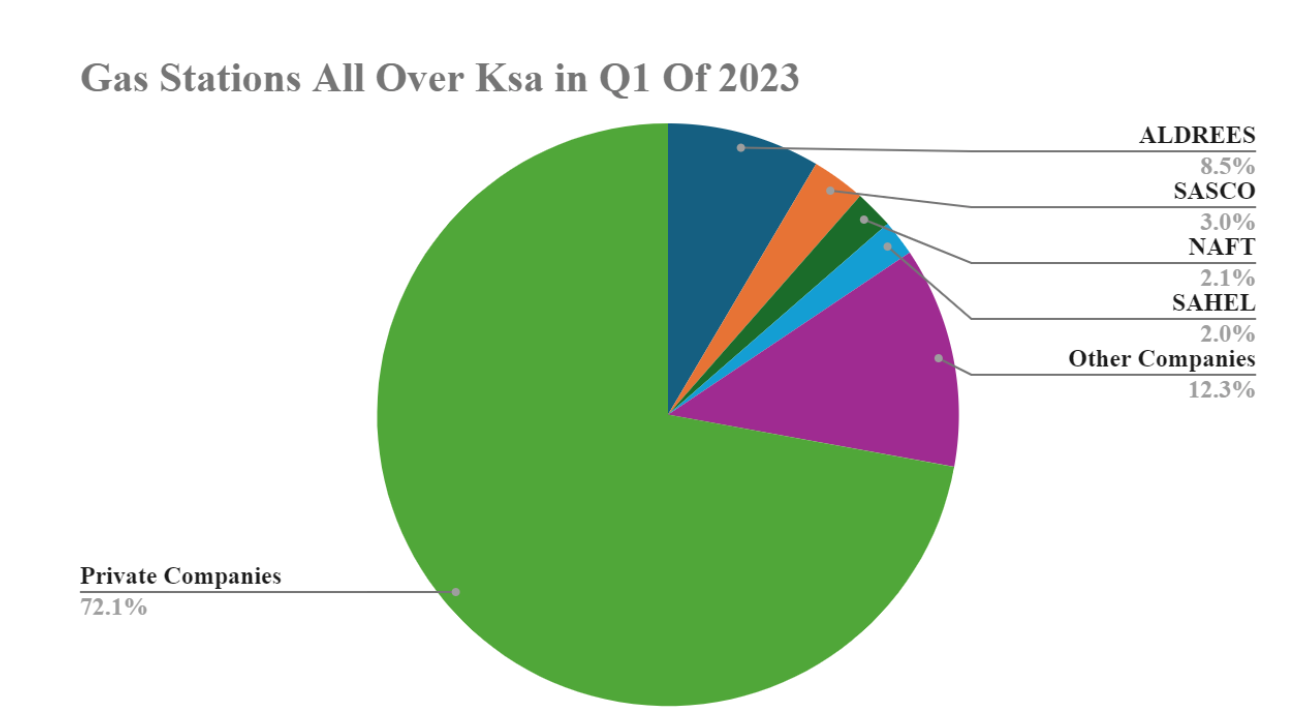
Developments in the Sector:
In Saudi Arabia, the retail fuel sector has seen significant developments in recent years. The industry has shifted towards sustainability and clean energy, with increasing investments in fuel stations powered by solar and wind energy. There has also been substantial technological advancement, enhancing customer experience through electronic payment apps and smart services at stations. Companies have diversified their offerings to include small retail stores and maintenance services, reflecting a transition towards integrated customer experiences.
The Future of the Sector:
In Saudi Arabia, the fuel retail sector is seeing a transformative shift due to Saudi Aramco's involvement, the kingdom's move towards sustainable transportation, technological advancements, and evolving consumer behaviors. Aramco's significant investments intensify competition, diversify services, and emphasize sustainability. Technology simplifies payments, improves operations, and enhances personalized customer experiences at fuel stations, which are becoming integrated hubs meeting sophisticated consumer demands. However, challenges like oil dependency and price fluctuations remain critical in shaping the sector's future path.
Sector and Vision 2030: The vision aiming to diversify the economy and reduce reliance on oil could lead to changes in the fuel station sector, including an increased focus on sustainability and renewable energy sources. Fuel stations may need to adapt by integrating electric vehicle charging stations and other alternative fuels as part of this transition.
Key external factors likely to impact SASCO can be identified and assessed using the strategic framework known as PESTEL analysis:

Competitor Overview
Al-Drees (a local company), Oula (a Kuwaiti company), and ADNOC (an Emirati company) were selected as competitors to SASCO because they provide significant financial comparison points. The annual revenues for these companies in 2023 in Saudi Riyals were: SASCO 9,500 million, Al-Drees 9,800 million, Oula 6,700 million, and ADNOC 23,000 million. Despite ADNOC’s high revenues, it was chosen because it operates fuel stations in Saudi Arabia, and cities like Riyadh and Jeddah, making it a direct competitor. All these companies operate in the fuel distribution sector in the Gulf region and face similar challenges and opportunities, enhancing the accuracy of the financial analysis of SASCO's market position.
- Local Competitor:
Al-Drees Petroleum and Transport Services Company:
Al-Drees Petroleum and Transport Services Company, also known as Al-Drees, was established in 1962 in Riyadh. The company operates in the trade of petroleum products and transport services, managing approximately 600 fuel stations across Saudi Arabia. Recently, Al-Drees announced plans to increase its capital to 600 million SAR and signed an agreement with the UAE's ENOC to operate modern fuel stations within the kingdom. Additionally, the company is seeking international expansion by offering to acquire 60 fuel stations in Egypt.
- Regional Competitors:
Oula Fuel Marketing Company - OULA:
Oula Fuel Marketing Company (Oula Fuel) is a Kuwaiti company established in May 2004, operating in the fuel refining and marketing sector. The company runs fuel stations and offers various energy-related services. In the first quarter of 2023, the company saw a 61% increase in profits, and in the second quarter, a 36% year-on-year increase. One of its notable shareholders is Kuwait Petroleum Corporation, holding a 24% stake. The company also recently distributed cash dividends of 5 fils per share.
ADNOC (Abu Dhabi National Oil Company for Distribution):
ADNOC Group, established in 1971 and wholly owned by the Abu Dhabi government, is one of the leading global companies in the energy sector. The group comprises an integrated array of specialized companies that cover all aspects of the energy industry, from exploration and production to refining and distribution, ensuring the effective and efficient fulfillment of the evolving global market needs.
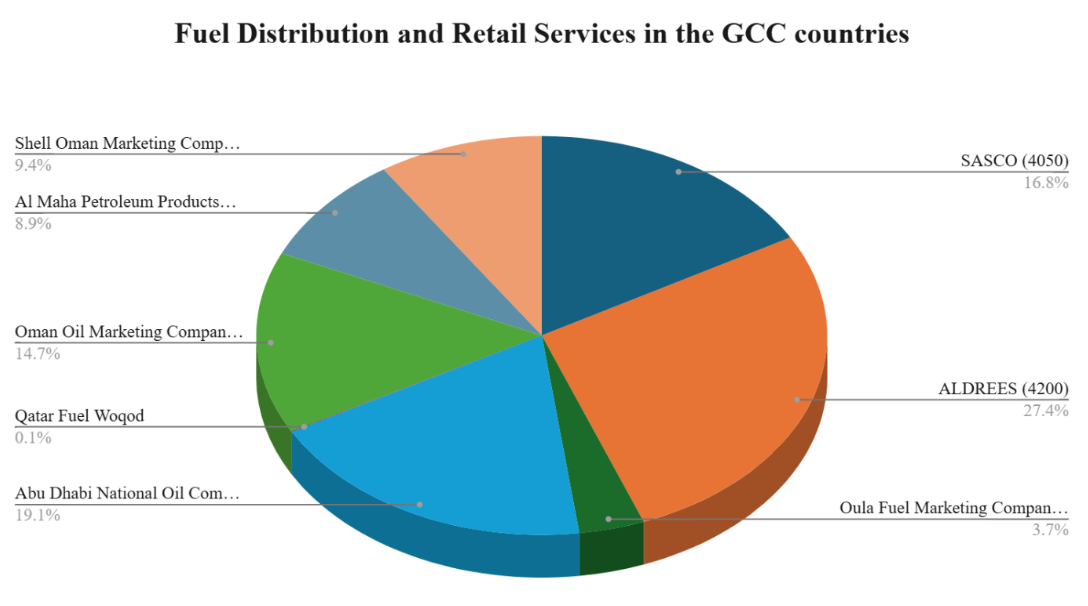
Note: Bahrain does not have publicly listed fuel station companies in the financial market. Most fuel stations in Bahrain are operated by private companies or government institutions.
Finally, we will show a comparison between some of the financial ratios of Saudi Automotive Services Company (SASCO) and its competitors:
Profitability Ratios:
Profitability ratios are financial indicators used to assess a company's ability to generate profits relative to its revenue, assets, or shareholders' equity. These ratios help investors and analysts understand the efficiency of a company in generating profits and analyze its financial performance. To measure profitability, we used several indicators including Return on Assets (ROA), Return on Equity (ROE), and Net Profit Margin.
Return on Assets (ROA):
The Return on Assets ratio can provide investors with an idea of how well a company is performing in investing its assets. The higher this ratio, the more efficient the company is in managing and investing its assets.
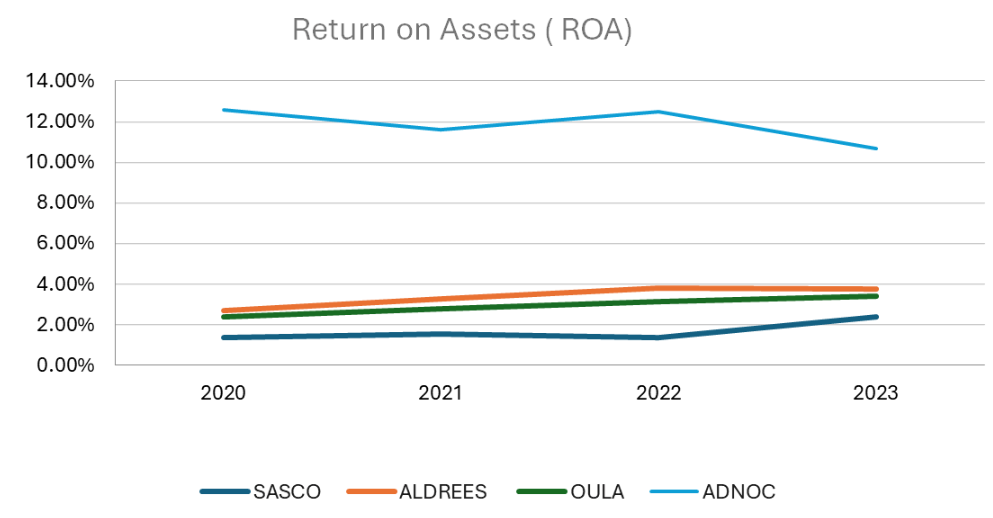
The chart shows that SASCO experienced fluctuations in the Return on Assets (ROA) from 2020 to 2023, starting at 1.34% in 2020. The indicator then slightly decreased the following year before rising again in 2023 to reach its highest level. Compared to SASCO, companies such as Al-Drees and Oula achieved higher and more stable ROA levels, At the same time ADNOC generally had a higher ROA than SASCO throughout the mentioned period.
Net Profit Margin (NPM):
Net Profit Margin is one of the most important indicators of a company's overall financial health. It is expressed as a percentage and represents the amount of net profit generated from each dollar of revenue. The Net Profit Margin helps investors evaluate whether the company's management is generating sufficient profits from its sales and whether operating and general costs are under control.

The chart shows the Net Profit Margin (NPM), It indicates that SASCO started with an NPM of less than 2% in 2020, which remained relatively stable with slight increases in 2023. In contrast, ADNOC began with a high NPM of around 15% in 2020, but this margin continuously declined to less than 8% in 2023. Meanwhile, the NPMs for Al-Drees and Oula remained in the range of 1% to 3%, showing relative stability with slight increases. SASCO needs to enhance its operational efficiency to increase its NPM and keep up with market competition, especially given the relative stability in the performance of its competitors.
Return on Equity (ROE):
Return on Equity (ROE) is an important measure that illustrates how efficiently a company generates profits using shareholders' equity.
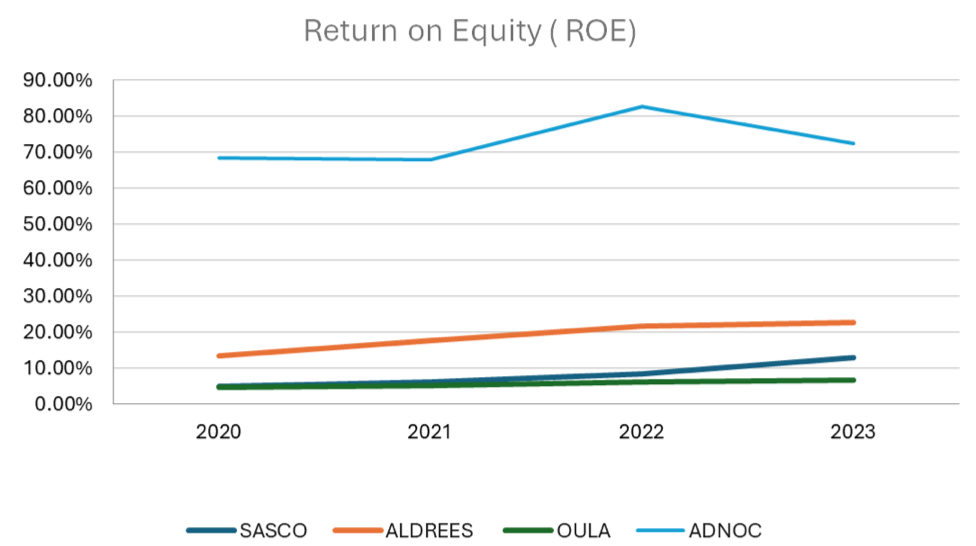
The chart displays the Return on Equity (ROE), It can be observed that SASCO's performance showed relative stability with slight increases over the years. In 2020, SASCO's ROE was around 10%, and it gradually rose to approximately 15% in 2023. Compared to other companies, ADNOC exhibited outstanding performance, peaking in 2022 at nearly 80% before declining in 2023. Al-Drees saw a steady increase from around 15% in 2020 to nearly 25% in 2023. Meanwhile, Oula maintained relative stability with slight increases over the years. This indicates that SASCO has maintained stable performance with gradual improvement in ROE during the displayed period, while ADNOC experienced a significant increase in 2022.
Debt Ratio:
The debt ratio is a measure that expresses the extent to which a company relies on debt to finance its assets.

The chart displays the debt ratios. It can be observed that SASCO's debt ratio was relatively stable around 80% in 2020. In 2021, the ratio decreased to approximately 60%, but it started rising again in 2022 and continued this trend until 2023, nearing 80% once more. In comparison, ADNOC experienced more significant fluctuations in its debt ratios, starting at around 100% in 2020, decreasing in 2021, and then rising sharply to exceed 120% in 2023. On the other hand, Al-Drees and Oula maintained more stable and less volatile debt ratios over the years. These analyses suggest that SASCO has been striving to control its debt more effectively despite the challenges it faced, leading to a temporary improvement in the debt ratio before it rose again.
Asset Turnover:
The asset turnover ratio is a measure that illustrates how efficiently a company uses its assets to generate revenue.

The chart indicates a gradual improvement in SASCO's asset utilization efficiency from 2020 to 2023, with a continuous rise in the asset turnover ratio. This demonstrates the company's increasing ability to generate revenue from each Riyal invested in assets. Although companies like ADNOC and Aldrees achieved higher returns on their assets, indicating higher efficiency in asset management or operation in higher-margin sectors, the consistent improvement in SASCO's asset turnover ratio is a positive sign for enhanced operations and increased efficiency. As for Oula showed stability in its asset turnover ratio over the same period, indicating stable operations and asset utilization but without significant increases.
Inventory Turnover Ratio:
The inventory turnover ratio is a measure that indicates how efficiently a company manages its inventory and converts it into sales.
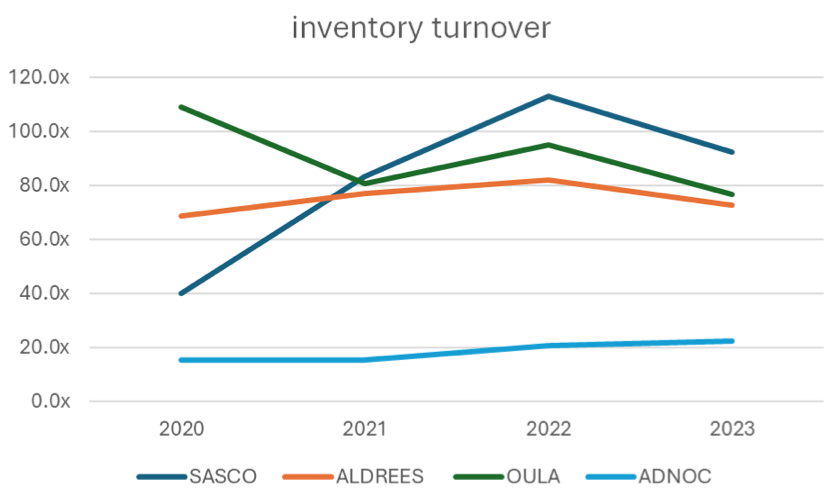
The chart shows that SASCO experienced a significant improvement in its inventory turnover ratio from 2020 to 2023, with the ratio increasing steadily. This reflects the company's growing efficiency in managing inventory and selling goods faster, thereby reducing storage costs. Compared to ADNOC, which also saw improvement in its inventory turnover, SASCO started from a lower level but experienced a larger increase, indicating greater efforts to enhance its inventory management. However, Al-Drees and OULA maintained higher inventory turnover levels throughout the period, which may reflect differences in industry nature or inventory management strategies. Overall, the continuous improvement in SASCO's inventory turnover ratio is a positive indication of the company's operational enhancement and increased profitability
Click here for the full analysis!
References:
https://www.sasco.com.sa/api/temp/2023/5/d097e215-0590-492f-919b-d63b67910adb.pdf
https://www.sasco.com.sa/api/temp/2023/5/d097e215-0590-492f-919b-d63b67910adb.pdf
https://www.aldrees.com/english/index
https://www.investopedia.com/terms/n/net_margin.asp
https://www.vision2030.gov.sa/media/5ptbkbxn/saudi_vision2030_ar.pdf
https://www.mordorintelligence.com/ar/industry-reports/saudi-arabia-fuel-station-
market https://www.abhacci.org.sa/ar/Centers/ResearchCenter/EServices/SouthBulletins/Documents/Electric-Car.pdf
https://attaqa.net/2024/01/01/
https://www.mordorintelligence.com/ar/industry-reports/saudi-arabia-fuel-station-market
https://attaqa.net/2022/02/14/
Prepared By:
Malak Sultan Aljaber